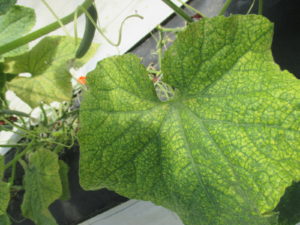We have received a number of reports of spider mite problems lately. Some of them have been on crops grown in high tunnels, particularly tomatoes and cucumbers.
High tunnels are the perfect environment for mites because it is hot, which means they reproduce faster, and the mites are protected from rainfall, which is a major mortality factor for them. So far, our efforts to develop biological control strategies for mites in high tunnels have been unsuccessful. Therefore, chemical control is often required. One important point is that you should start the management process early, before the mites get out of hand. Don’t wait until you have a disaster before you take action. Check the Midwest Vegetable Production Guide for the miticides labeled for use on your crop, and then check the table on page 45 to see if it can be used in greenhouses or high tunnels.
Most of the reports of mite problems outdoors have been on melons. Mites on muskmelons are not as worrisome as on watermelons because they will not affect the texture of the fruit. However, they can also affect the growth and yield of both muskmelons and watermelons. If you detect an early infestation of mites, mark the location and come back in a few days and see if it is increasing. If it is, you should take action. If not, continue to monitor the situation every few days. If you find a serious infestation, check the weather forecast before spraying. If heavy rains are predicted, you may get some control by the rain washing the mites off the plants. If possible wait until after the rain to spray (after the field dries). If no rain is in the forecast, you should treat as soon as possible. When populations are heavy, it often takes more than one application to achieve control. Wait at least a week, or whatever the label says, before making a second application. If the control with the first spray is totally unacceptable, change to a different product with a different mode of action.
